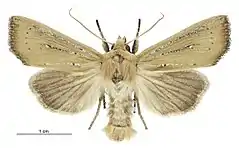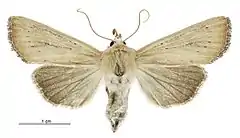Tmetolophota blenheimensis
Tmetolophota blenheimensis is a species of moth in the family Noctuidae. It is endemic to New Zealand. It is classified as "At Risk, Naturally Uncommon" by the Department of Conservation.
| Tmetolophota blenheimensis | |
|---|---|
 | |
| Male | |
 | |
| Female | |
| Scientific classification | |
| Kingdom: | |
| Phylum: | |
| Class: | |
| Order: | |
| Family: | |
| Genus: | |
| Species: | T. blenheimensis |
| Binomial name | |
| Tmetolophota blenheimensis | |
| Synonyms[2] | |
| |
Taxonomy
This species was described by Richard William Fereday in 1883 using a female specimen collected by William Skellon in Meanee near Napier.[3][4] Fereday named the species Leucania blenheimensis.[4] In 1887 Edward Meyrick described the male of the species.[5] George Hudson discussed and illustrated this species under this name in both his 1898 and 1928 publications.[6][7] In 1971 John S. Dugdale transferred all the New Zealand species in the genus Leucania to the genus Tmetolophota.[4][8] The lectotype specimen is held at the Canterbury Museum.[4] In 2019 Robert J. B. Hoare undertook a major review of New Zealand noctuids. Hoare, having inspected the type material of this species, placed it within the genus Ichneutica.[9]
Description
Hudson described the species as follows:
The expansion of the wings is about 1 1⁄2 inches. The fore-wings are cream-coloured with the veins darker ; there are three faint black dots at about one-third, a curved series of black dots near the termen, the termen itself being strongly shaded with dark greyish-brown; the cilia are dark greyish- brown. The hind-wings are grey, paler towards the base ; the cilia are also grey.[6]
Distribution
This species is endemic to New Zealand.[1][10] The range of this species covers the Hawkes Bay, Marlborough, Dunedin, Otago Lakes, Southland and the Stewart Island regions.[11] Along with the type locality of Meanee, specimens have also been collected at the Denniston plateau,[12] Blenheim,[3] Dunedin, Lake Wakatipu and Routeburn.[7]
Biology and behaviour
This species is on the wing from November to March.[7] It has been collected via sugar traps.[3]
Host species and habitat
This host plant for the larvae of this species is likely to be the golden sand sedge pīngao which is now absent from the moths type locality.[11]
Conservation Status
This species has been classified as having the "At Risk, Naturally Uncommon" conservation status under the New Zealand Threat Classification System.[13]
References
- "Tmetolophota blenheimensis (Fereday, 1883)". www.nzor.org.nz. Landcare Research New Zealand Ltd. Retrieved 2017-07-06.
- "blenheimensis - Taxonomy". insectoid.info. Retrieved 26 May 2018.
- Fereday, R. W. (1883). "Description of two new species of Heteropterous Lepidoptera". Transactions and Proceedings of the New Zealand Institute. 15: 195–196 – via Biodiversity Heritage Library.
- Dugdale, J. S. (1988). "Lepidoptera - annotated catalogue, and keys to family-group taxa" (PDF). Fauna of New Zealand. 14: 209 – via Landcare Research New Zealand Ltd.
- Meyrick, Edward (1887). "Monograph of New Zealand Noctuina". Transactions and Proceedings of the New Zealand Institute. 19: 3–40 – via Biodiversity Heritage Library.
- Hudson, G. V. (1898). New Zealand moths and butterflies (Macro-lepidoptera). London: West, Newman & Co. p. 13. doi:10.5962/bhl.title.32466. OCLC 727236768.
- Hudson, G. V. (1928). The Butterflies and Moths of New Zealand. Wellington: Ferguson & Osborn Ltd. p. 53. OCLC 25449322.
- Dugdale, J.S. (1971). "Entomology of the Aucklands and other islands south of New Zealand: Lepidoptera, excluding non-crambine Pyralidae" (PDF). Pacific Insects Monograph. 27: 55–172.
- Hoare, Robert J. B. (2019-12-09). "Noctuinae (Insecta: Lepidoptera: Noctuidae) part 2: Nivetica, Ichneutica". Fauna of New Zealand. 80: 1–455. doi:10.7931/J2/FNZ.80.
- Gordon, Dennis P., ed. (2010). New Zealand inventory of biodiversity. Volume two. Kingdom animalia : chaetognatha, ecdysozoa, ichnofossils. Vol. 2. Christchurch, N.Z.: Canterbury University Press. p. 461. ISBN 9781877257933. OCLC 973607714.
- Patrick, Brian; Dugdale, John S. (2000). Conservation status of the New Zealand lepidoptera (PDF). Wellington, N.Z.: Department of Conservation, New Zealand. p. 27. ISBN 0478218672. OCLC 154670803.
- "Lepidoptera discoveries in high places" (PDF). Butterflies and Moths of New Zealand. 1: 8. 2012.
- Hoare, R.J.B.; Dugdale, J.S.; Edwards, E.D.; Gibbs, G.W.; Patrick, B.H.; Hitchmough, R.A.; Rolfe, J.R. (2017). "Conservation status of New Zealand butterflies and moths (Lepidoptera), 2015" (PDF). New Zealand Threat Classification Series. 20: 9.
External links
| Wikimedia Commons has media related to Tmetolophota blenheimensis. |
| Wikispecies has information related to Tmetolophota blenheimensis. |